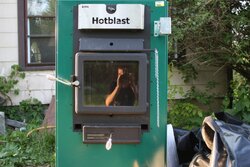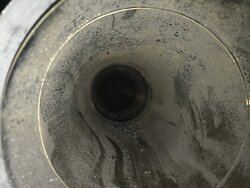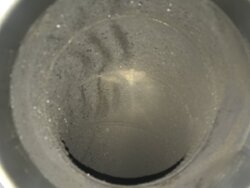Damn you lol, I was replying in the other thread about the shared primary/secondary air and you said everything I wanted to. It's funny on the caddy, I can have a beautiful clean fire and as soon as i block the secondary openings, it's a mess. It's impossible to have a shared channel and direct the right amount of primary and secondary air where needed. It really is a balance, and that's why there's multiple channels on the caddy, tundra, Kuuma etc.Heres my take on the issue with this unit...
The single intake for primary and secondary air...and that little tiny 3/8 opening they want set on the draft blower.
When the blower is on it may be pushing 10 CFM through the firebox (under "pressure") so that may be plenty of air volume to be spread around to all the various primary and secondary holes.
When the blower is off the chimney is now responsible for all the incoming air (negative pressure being drawn on the firebox)
So IMO the total volume of air is gonna drop way down from what was being forced through there by the draft blower. And here is the issue...the volume is now so low that the air can just take the path of least resistance...which again, IMO, will be those rather large primary air holes (that is also the shortest path for the air too) so once the blower shuts off, we are still feeding the fire primary air, but very little, if any, air is getting to the secondary air tube...so now we have a smoky primary air fueled fire (smoky because we just turned the volume of air way down when the blower suddenly shut off) and no secondary air to burn off the smoke/wood gas...eventually the fire totally smolders out, wood gas/smoke builds up...time goes by and the air/fuel ratio eventually falls into the range of "BOOM"...and well, here we are.
Fire Chief or Shelter EPA stoves feedback
- Thread starter Mrpelletburner
- Start date
-
Active since 1995, Hearth.com is THE place on the internet for free information and advice about wood stoves, pellet stoves and other energy saving equipment.
We strive to provide opinions, articles, discussions and history related to Hearth Products and in a more general sense, energy issues.
We promote the EFFICIENT, RESPONSIBLE, CLEAN and SAFE use of all fuels, whether renewable or fossil.
You are using an out of date browser. It may not display this or other websites correctly.
You should upgrade or use an alternative browser.
You should upgrade or use an alternative browser.
so once the blower shuts off, we are still feeding the fire primary air, but very little, if any, air is getting to the secondary air tube...so now we have a smoky primary air fueled fire (smoky because we just turned the volume of air way down when the blower suddenly shut off) and no secondary air to burn off the smoke/wood gas...eventually the fire totally smolders out, wood gas/smoke builds up...time goes by and the air/fuel ratio eventually falls into the range of "BOOM"...and well, here we are.
Hope this post made sense to y'all...
It does.. however the "boom" happens when the draft blower is running. Which then has you think about the flue temp and draft, which appears to be "in spec".
Damn you lol, I was replying in the other thread about the shared primary/secondary air and you said everything I wanted to. It's funny on the caddy, I can have a beautiful clean fire and as soon as i block the secondary openings, it's a mess. It's impossible to have a shared channel and direct the right amount of primary and secondary air where needed. It really is a balance, and that's why there's multiple channels on the caddy, tundra, Kuuma etc.
Any chance you Can post a photo or point me to a good photo of the primary and secondary air on the caddy?
Any chance you Can post a photo or point me to a good photo of the primary and secondary air on the caddy?
Sure, these photos are from the furnace when it was new. It's a rebadged caddy, so don't be confused by the name lol. The primary flap is above the loading door with a 3/4" hole. When it opens, there's 3 openings under it approximately 1x2" or so (primary). On the left and right side below the door, there's two 1.5 x 1.5 inch openings for the secondary air. Below the loading door in the center is an opening with a 1/4" pilot hole inside and a 1/4" hole in the rear of the firebox. Our firebox is 3.5 cu.ft, and even with all the air, we get 8-12 hour burns without any problems. I've calculated before, and I think there's around 2.5 to 3 square inches of incoming air.
Attachments
brenndatomu
Minister of Fire
My calculations show ~5 sq inches of intake when the damper is closed...~11sq inches total when the damper is open...although I doubt much air is being drawn through all those tiny holes in the 3 secondary tubes when the damper is open...path of least resistance and all.I've calculated before, and I think there's around 2.5 to 3 square inches of incoming air.
That is a TON more air than they are allowing into the FC firebox! Even if the blower flapper was wide open on the FC, Caddy has probably double the air intake area...with a smaller firebox!
Not to steal your thunder @laynes69 , but just wanted to further clarify something for @Mrpelletburner...those air intake openings shown in your picture there.
There are two 1.5" x 1.5" holes right at the lower outside corners of the black area on the furnace front. (secondary air)
Then there is that 3/4" round hole a few inches above the glass door...right in the center. (primary "pilot" air)
When that flapper door opens up, the 3/4" round hole is taken out of the picture, and (3) 1" x 2" slots are uncovered. (primary air)
If you look at the back of the firebox, see the metal tube that goes halfway up the middle? There is a 1/4" round hole there too (secondary air)
There is also another 1/4 hole right below the loading door, in the center. (another primary "pilot" air) It blows right on the hot coals...works great for firing off a new load of wood!
I know all this only because the Tundra firebox is almost identical to the Caddys.
Last edited:
brenndatomu
Minister of Fire
Sorry, had I known you were preparing a reply, I would have left you roll wit it...would have probably been better explained and less long winded!Damn you lol, I was replying in the other thread about the shared primary/secondary air and you said everything I wanted to

brenndatomu
Minister of Fire
Really?! That is just crazy!It does.. however the "boom" happens when the draft blower is running.

Lol, I tried going off my memory (which sucks obviously)! I've calculated it quite a few times. Either way it's a metric ton more than the firecheif.My calculations show ~5 sq inches of intake when the damper is closed...~11sq inches total when the damper is open...although I doubt much air is being drawn through all those tiny holes in the 3 secondary tubes...path of least resistance and all.
That is a TON more air than they are allowing into the FC firebox! Even if the blower flapper was wide open on the FC, Caddy has probably double the air intake area...with a smaller firebox!
Not to steal your thunder @laynes69 , but just wanted to further clarify something for @Mrpelletburner...those air intake openings shown in your picture there.
The are two 1.5" x 1.5" holes right at the lower outside corners of the black area on the furnace front. (secondary air)
Then there is that 3/4" round hole a few inches above the glass door...right in the center. (primary "pilot" air)
When that flapper door opens up, the 3/4" round hole is taken out of the picture, and (3) 1" x 2" slots are uncovered. (primary air)
If you look at the back of the firebox, see the metal tube that goes halfway up the middle? There is a 1/4" round hole there too (secondary air)
There is also another 1/4 hole right below the loading door, in the center. (another primary "pilot" air) It blows right on the hot coals...works great for firing off a new load of wood!
I know all this only because the Tundra firebox is almost identical to the Caddys.
Medic21
Minister of Fire
Really?! That is just crazy!
Not really, same principle in firefighting. Blower kicks on and introduces air into a super heated environment. If you want to control a structure fire you limit air with controlling doors and other openings. When you have heat and fuel all your missing from the tetrahedron is oxygen. Get the right mix and boom. We only open that door back up when we are ready to flow water. Flowing water high into the room cools the atmosphere taking the heat when it get oxygen. That is without putting a drop of water on the actual fire. I'm using the video of opening the door in a power point on backdraft lol.
Personally I would never light the furnace again until I found out what made it explode with enough force to remove the baro. The firefighter in me thinks that's a structure fire waiting to happen, what if it blows the tee or elbow off next time?
brenndatomu
Minister of Fire
Right, but my impression was that the blower was running for a long time before the boom...if it happens soon after the blower kicks on, that totally makes sense...but not after extended blower run time...Not really, same principle in firefighting. Blower kicks on and introduces air into a super heated environment. If you want to control a structure fire you limit air with controlling doors and other openings. When you have heat and fuel all your missing from the tetrahedron is oxygen.
Medic21
Minister of Fire
Right, but my impression was that the blower was running for a long time before the boom...if it happens soon after the blower kicks on, that totally makes sense...but not after extended blower run time...
True, it's odd that there would be enough off gassing going on that long into a burn to create that kind of atmosphere. Off gassing usually stops and the end of the growth/free burn stage, hence the decay stage at that point. I don't recall what kind of wood but, it wasn't any kind of high resin wood or anything he said he was using. Still makes me think fuel issues as much as air. I have never have that violent of a "puff". The other issue would be high levels of CO. It is as explosive as natural gas. As much smoke as I see while it is burning maybe he needs to quit looking at the firebox temp and go off stack temps more I have seen a dull red for a brief period so I know I'm pushing 900-1000 degrees around the left side and top of the door occasionally. I thought at the high I was seeing 600 in the stack. In fact, after adding the auber, I was spiking to 800-900 while firing a new load but, not long enough for the probe to reach those temps or damage anything. Incomplete burning creats CO and I have a hard time thinking wood smoke would be a rich enough fuel to puff that violently, literally explode but CO will.
The gentleman I spoke with tonight was very professional and I am going to send pictures to him when I get a chance to not be in the shop. I still think, and I'm no expert in anyway, that a way to add air between calls for heat would solve this problem. I only experience it now when I keep the house cooler than 72. Above that no issues at all. I think that has to do with long burn times and more complete burning. Problem is I am useing quite a bit more wood than I want to when I keep it that warm.
Medic21
Minister of Fire
Fire box after a 1.5 months after burning. Also shows area above the fire box.
I will say from that video you are not burning hot enough. Do not be a slave to a thermometer. I have zero Stage 1 creosote in the fire box and only stage 1 in the entire flue. I see stage 2 in the firebox and up by the flue.
Do not be a slave to a thermometer.
Not following... Thought the stove has been burning hot, sounds like not hot enough.
Medic21
Minister of Fire
Not following... Thought the stove has been burning hot, sounds like not hot enough.
Creosote only builds with incomplete combustion. You will always have some, the goal is the soot like stage one. What temps are your flue pipe getting to?
Medic21
Minister of Fire
maple1
Minister of Fire
I will say from that video you are not burning hot enough. Do not be a slave to a thermometer. I have zero Stage 1 creosote in the fire box and only stage 1 in the entire flue. I see stage 2 in the firebox and up by the flue.
It could also be that something about his unit is not allowing it to burn properly. I'm not going to re-read but also thought he was going by what he was being instructed to do by the service guy, re. temps and all. I'm still thinking that it is burning too much in primary and not enough in secondary.
Two months worth on the flue pipe just past the outlet of the stove. View attachment 224468View attachment 224469
Yea.. mine is like a poster child for creosote build up.
Having been loading the stove at the end of the burn cycle. When starting the stove, ash door opened to get the fire going, would say the flue pipe reaches 400-500 degrees, same when the stove hits max burn. However when the stove is just trucking along, would say 175-250 degrees.
As I recall you have a double wall flue pipe?
Medic21
Minister of Fire
As I recall you have a double wall flue pipe?
Yes, that is probably the only difference in install now that you have a liner. I have half the natural draft you have. I'm still thinking I get the firebox hotter than you are and that is the biggest difference. I will still get an occasional puff but that is with strong wind out of the east or south and warmer temps outside.
I see zero smoke outside of the initial firing and for a min or two when the inducer turns on. Even when loading there is very little smoke.
The only time I don't see smoke is when the temperature on the front of the stove is above 650. Stove only stays at or above that temperature for 20min at a time.
Medic21
Minister of Fire
The only time I don't see smoke is when the temperature on the front of the stove is above 650. Stove only stays at or above that temperature for 20min at a time.
Mine holds at 800-850 with infrared Snap On thermometer measured at the edge of the door opening and on top during the first hour. Flue on probe is 500-600 during that period. If it gets a little red I close off the air a tad bit. I never asked what kind of temps I should see I just run it where it is still safe. My puffing stopped for the most part when I did that.
I'll take a video of when I fire it and when I load it for you. Shoot me an email address ina message. I'm on shift for 24 today and will be home tomorrow.
brenndatomu
Minister of Fire
Anything under 250 or so is gonna cause buildup...unless it is at the end of the fire when everything is burning out.would say the flue pipe reaches 400-500 degrees, same when the stove hits max burn. However when the stove is just trucking along, would say 175-250 degrees.
But even with higher temps, if the fire is as smoky as was in the video you had the other day with holding the baro door open...you are gonna have creosote buildup.
But I really think the low flue temps and the smoke go hand in hand...the fire is choked out and then smolders away...makes tons of smoke and low flue temps...until the next BOOM.
brenndatomu
Minister of Fire
That's it right there...you opened up the air...fire not being starved.If it gets a little red I close off the air a tad bit
How far open is your damper usually?
Similar threads
- Replies
- 47
- Views
- 6K
- Replies
- 0
- Views
- 10K




